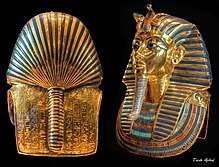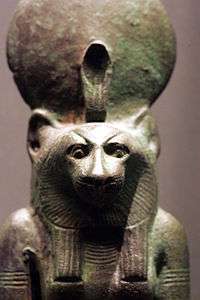Wadjet
Wadjet (/ˈwɑːdˌdʒɛt/ or /ˈwædˌdʒɛt/; Ancient Egyptian: wꜢḏyt "Green One"),[1] known to the Greek world as Uto (Koine Greek: Οὐτώ /ˈuːtoʊ/) or Buto (Βουτώ /ˈbuːtoʊ/) among other names including Wedjat, Uadjet, and Udjo [2] was originally the ancient local goddess of the city of Dep.[3] It became part of the city that the Egyptians named Per-Wadjet "House of Wadjet" and the Greeks called Buto (now Desouk),[4] which was an important site in prehistoric Egypt and the cultural developments of the Paleolithic.
Wadjet was said to be the patron and protector of Lower Egypt, and upon unification with Upper Egypt, the joint protector and patron of all of Egypt "goddess" of Upper Egypt. The image of Wadjet with the sun disk is called the uraeus, and it was the emblem on the crown of the rulers of Lower Egypt. She was also the protector of kings and of women in childbirth. Wadjet was said to be the nurse of the infant god Horus. With the help of his mother Isis, they protected Horus from his treacherous uncle, Set, when they took refuge in the swamps of the Nile Delta. [5]
The "Going Forth of Wadjet" was celebrated on December 25 with chants and songs. An annual festival held in the city celebrated Wadjet on April 21. Other important dates for special worship of her were June 21, the summer solstice, and March 14. She also was assigned the fifth hour of the fifth day of the moon.
Wadjet was closely associated in ancient Egyptian religion with the Eye of Ra, a powerful protective deity. The hieroglyph for her eye is shown below; sometimes two are shown in the sky of religious images. Per-Wadjet also contained a sanctuary of Horus, the child of the sun deity who would be interpreted to represent the pharaoh. Much later, Wadjet became associated with Isis as well as with many other deities.
In the relief shown to the right, which is on the wall of the Mortuary Temple of Hatshepsut at Luxor, there are two images of Wadjet: one of her as the uraeus with her head through an ankh and another where she precedes a Horus hawk wearing the Pschent, representing the pharaoh whom she protects.
Appearance
As the patron goddess, she was associated with the land and depicted as a snake-headed woman or a snake—usually an Egyptian cobra, a venomous snake common to the region; sometimes she was depicted as a woman with two snake heads and, at other times, a snake with a woman's head. Her oracle was in the renowned temple in Per-Wadjet that was dedicated to her worship and gave the city its name. This oracle may have been the source for the oracular tradition that spread to Greece from Egypt.[6]
The Egyptian word wꜣḏ signifies blue and green. It is also the name for the well-known "Eye of the Moon".[7] Indeed, in later times, she was often depicted simply as a woman with a snake's head, or as a woman wearing the uraeus. The uraeus originally had been her body alone, which wrapped around or was coiled upon the head of the pharaoh or another deity.
Wadjet was depicted as a cobra. As patron and protector, later Wadjet often was shown coiled upon the head of Ra; in order to act as his protection, this image of her became the uraeus symbol used on the royal crowns as well.
Another early depiction of Wadjet is as a cobra entwined around a papyrus stem, beginning in the Predynastic era (prior to 3100 B.C.) and it is thought to be the first image that shows a snake entwined around a staff symbol. This is a sacred image that appeared repeatedly in the later images and myths of cultures surrounding the Mediterranean Sea, called the caduceus, which may have had separate origins.
Her image also rears up from the staff of the "flagpoles" that are used to indicate deities, as seen in the hieroglyph for "uraeus" and for "goddess" in other places.
Etymology
| wȝḏyt in hieroglyphs |
|---|
| cobra+Sun in hieroglyphs |
|---|
| ḏt "cobra" in hieroglyphs |
|---|
The name Wadjet[8] is derived from the term for the symbol of her domain, Lower Egypt, the papyrus.[9] Its hieroglyphs differ from those of the Green Crown or Deshret of Lower Egypt only by the determinative, which in the case of the crown was a picture of the Green Crown[10] and, in the case of the goddess, a rearing cobra.
The goddess Wadjet appears in the form of the living Uraeus to anoint your head with her flames. She rises up on the left side of your head and she shines from the right side of your temples without speech; she rises up on your head during each and every hour of the day, even as she does for her father Ra, and through her the terror which you inspire in the spirits is increased … she will never leave you, are of you strikes into the souls which are made perfect. - The Book of the Dead[11]
Protector of country, pharaohs, and other deities
| Wadjet - Eye of Horus in hieroglyphs |
|---|
Eventually, Wadjet was claimed as the patron goddess and protector of the whole of Lower Egypt and became associated with Nekhbet, depicted as a white vulture, who held unified Egypt. After the unification the image of Nekhbet joined Wadjet on the crown, thereafter shown as part of the uraeus.
Wadjet was associated with the Nile Delta region and was more associated with the world of the living. She was closely linked to pharaohs as a protective deity. She was associated, along with other goddesses, as the ‘eye of Ra’. Wadjet was often depicted as an erect cobra with its hood extended as though she were ready to strike. At times she was depicted wearing the Red Crown of Lower Egypt. Wadjet was depicted many times in her cobra form alongside her Upper Egyptian counterpart Nekhbet, in her vulture form wearing the Red Crown on wall paintings or on the pharaoh's headdress. [12]
Associations with other deities

An interpretation of the Milky Way was that it was the primal snake, Wadjet, the protector of Egypt. In this interpretation she was closely associated with Hathor and other early deities among the various aspects of the great mother goddess, including Mut and Naunet. The association with Hathor brought her son Horus into association also. The cult of Ra absorbed most of Horus's traits and included the protective eye of Wadjet that had shown her association with Hathor.
When identified as the protector of Ra, who was also a sun deity associated with heat and fire, she was sometimes said to be able to send fire onto those who might attack, just as the cobra spits poison into the eyes of its enemies.[13] In this role she was called the "Lady of Flame".
She later became identified with the war goddess of Lower Egypt, Bastet, who acted as another figure symbolic of the nation, consequently becoming Wadjet-Bast. In this role, since Bastet was a lioness, Wadjet-Bastet was often depicted with a lioness head.
After Lower Egypt had been conquered by Upper Egypt and they were unified, the lioness goddess of Upper Egypt, Sekhmet, was seen as the more powerful of the two warrior goddesses. It was Sekhmet who was seen as the "Avenger of Wrongs" and "the Scarlet Lady", a reference to blood, as the one with bloodlust. She is depicted with the solar disk and Wadjet, however.
Wadjet, Horus, Ra and Sekhmet were connected to the eclipsing binary Algol in the Calendar of Lucky and Unlucky Days of papyrus Cairo 86637.[14]
Eventually, Wadjet's position as patron led to her being identified as the more powerful goddess Mut, whose cult had come to the fore in conjunction with rise of the cult of Amun, and eventually being absorbed into her as the triple deity Mut-Wadjet-Bastet.
When the pairing of deities occurred in later Egyptian myths, since she was linked to the land, after the unification of Lower and Upper Egypt she came to be thought of as the wife of Hapi, a deity of the Nile, which flowed through the land.[15]
Wadjet, as the goddess of Lower Egypt, had a big temple at the ancient Imet (now Tell Nebesha) in the Nile Delta. She was worshipped in the area as the 'Lady of Imet'. Later she was joined by Min and Horus to form a triad of deities. This was based on an Osiriac model identified elsewhere in Egypt.[16]
Wadjet is not to be confused with the Egyptian demon Apep, who is also represented as a snake in ancient Egyptian religion.
Other uses
The Nazit Mons, a mountain on Venus, is named for Nazit, an "Egyptian winged serpent goddess".[17] According to Elizabeth Goldsmith, the Greek name for Nazit was Buto.[18]
See also
Footnotes
- ↑ Also spelled Wadjit, Wedjet, Uadjet or Ua Zit
- ↑ Budge, E. A. Wallis (1969). Gods of the Egyptians, The (Studies in Egyptian Mythology)
- ↑ Wilkinson, Early Dynastic Egypt, p.297
- ↑ Wörterbuch der ägyptischen Sprache, 1, 268.18
- ↑ "Wadjet | Egyptian goddess". Encyclopedia Britannica. Retrieved 2018-04-19.
- ↑ Herodotus ii. 55 and vii. 134
- ↑ Wörterbuch der ägyptischen Sprache 1, 268.13
- ↑ Wörterbuch der ägyptischen Sprache, 1, 268.17
- ↑ Wörterbuch der ägyptischen Sprache, 1, 263.7–264.4
- ↑ Wörterbuch der ägyptischen Sprache, 1, 268.16;
- ↑ "Wadjet – Cobra Goddess". 2012-02-20. Retrieved 2018-04-19.
- ↑ "Nekhbet and Wadjet". www.touregypt.net (in Russian). Retrieved 2018-04-19.
- ↑ Curl, James Stevens (2013). The Egyptian Revival: Ancient Egypt as the Inspiration for Design Motifs in the West. Routledge. p. 469. ISBN 978-1-134-23467-7.
- ↑ Jetsu, L.; Porceddu, S. (2015). "Shifting Milestones of Natural Sciences: The Ancient Egyptian Discovery of Algol's Period Confirmed". PLOS ONE. 10 (12): e.0144140 (23pp). doi:10.1371/journal.pone.0144140.
- ↑ Ruiz, Ana (2001). The Spirit of Ancient Egypt. Algora Publishing. p. 119. ISBN 978-1-892941-69-5.
- ↑ Vincent Razanajao, D'Imet à Tell Farâoun : recherches sur la géographie, les cultes et l'histoire d'une localité de Basse-Égypte orientale. (English synopsis)
- ↑ "Nazit Mons". Gazetteer of Planetary Nomenclature.
- ↑ Goldsmith, Elizabeth Edwards. Life Symbols as Related to Sex Symbolism. Putnam. p. 419.
References
- James Stevens Curl, The Egyptian Revival: Ancient Egypt as the Inspiration for Design Motifs in the West, Routledge 2005
- Adolf Erman, Hermann Grapow, Wörterbuch der ägyptischen Sprache, Berlin 1963
- Ana Ruiz, The Spirit of Ancient Egypt, Algora Publishing 2001
- Toby A. H. Wilkinson, Early Dynastic Egypt, Routledge 1999
External links
| Wikimedia Commons has media related to Wadjet. |
| Wikisource has the text of the 1911 Encyclopædia Britannica article Buto. |
